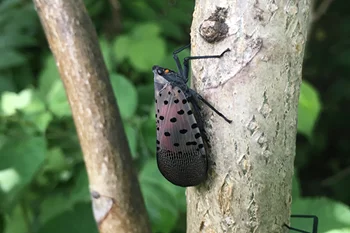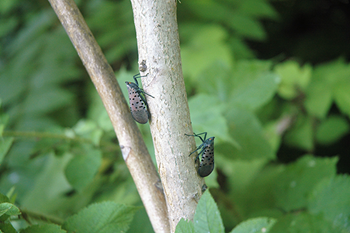
If you live in certain regions of the Northeastern United States, you may have noticed a new butterfly or moth-looking creature appear on different gray and green infrastructure. But don’t be fooled by this bug’s attractive looks—it is an invasive species that can damage trees and natural areas.
The spotted lanternfly (Lycorma delicatula) is an invasive insect native to China and was first detected in Pennsylvania in September 2014. Since then, it has spread to parts of New Jersey, New York, Delaware, Maryland, and Virginia. Presently, the pest has been found five counties away from Northeast Ohio, which will likely be infestedinfected as it spreads from upstate New York. (For more information on the spotted lanternfly’s migration patterns, click here).
The Great Deceiver
The adult spotted lanternfly is 1-inch long and ½-inch wide. Their large, visually striking wings feature a light brown, black, scarlet, and white color scheme. Despite these bugs looking like they belong in the Lepidoptera order, like moths or butterflies, they are part of the Hemiptera order and are considered true bugs or aphids.
Spotted lanternflies appear in late July and tend to gravitate toward trees-of-heaven (Ailanthus altissima) as their host plants, but also use fruit trees, vines, and shade trees as hosts. They lay thousands of eggs on smooth host plant surfaces and vertical man-made surfaces, which hatch in the spring and early summer and suck the sap from young stems and leaves of the host plant.
As adult lanternflies feed, they excrete a sticky, sugary substance called honeydew. This substance builds up on plants and on the ground underneath infested plants, causing sooty-looking mold to form. Plants are weakened when they are fed on by many spotted lanternflies at once, and the sooty-looking mold can also weaken plants beneath where they are feeding.

Urban Vs. Natural
Spotted lanternfly eggs are introduced to new regions by being transported on wood, crates, pallets, stone, and other manmade material or equipment. The pest and their discharge can be controlled in an urban setting with systemic and foliar pesticides, but this approach is not as cost-effective in natural areas. Because of this, it’s imperative to make sure there are no host plants present in those areas. Davey Resource Group, Inc. (DRG), can help you identify and remove invasive plants and pests.



